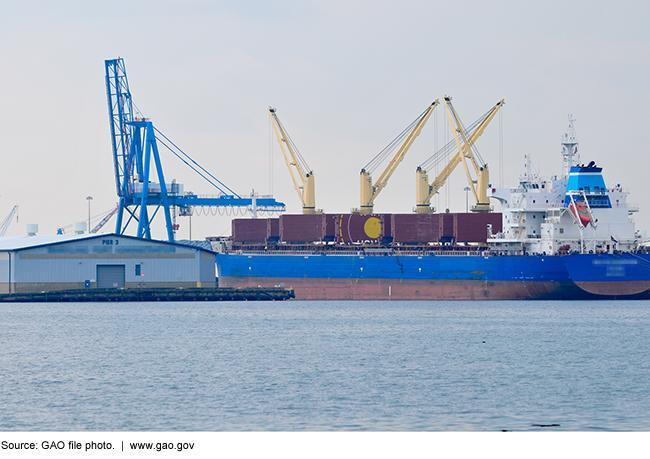Ocean Carrier Bankruptcies: Federal Agencies Have a Limited Role in Addressing Effects on Cargo
Fast Facts
In 2016, Hanjin Shipping (then the 7th-largest ocean carrier of container cargo in the world) went bankrupt and immediately ceased operations. Consequently, some companies shipping with Hanjin were affected by delays and extra costs.
Federal agencies can’t help much during such bankruptcies, but they can monitor the situation and share information with industry stakeholders. Federal officials told us that the legal and market response in 2016 effectively addressed the effects of the Hanjin bankruptcy.
Some companies are trying to reduce their risks in any future bankruptcies—e.g., by limiting how much cargo they ship with any one carrier.
Container Cargo Ship in Port

Cargo ship at a port
Highlights
What GAO Found
Fifteen stakeholders GAO interviewed mentioned cargo delays and additional costs as two primary effects on the movement of cargo shipped via ocean vessels resulting from the 2016 bankruptcy of the seventh largest ocean cargo carrier in the world, South Korea's Hanjin Shipping (Hanjin). While stakeholders did not cite any data or analysis that could help to quantify the extent of overall economic effects, they provided examples of delays and additional costs. For example, they explained that some cargo did not reach its final destination on time because Hanjin halted its vessels at sea for fear of arrest of such vessels at port on behalf of creditors. They added that some port facilities were reluctant to offload cargo associated with Hanjin until they received payment for port fees and labor services. Some cargo owners incurred additional costs to pay for services—such as the offloading and release of their cargo—which may have been included in fees they already had paid to Hanjin. While cargo delays were generally resolved in 4 to 8 weeks, other lingering issues took up to 3 months longer, such as a shortage of chassis (trailers that carry containers and attach to trucks). This shortage occurred because some ports refused to accept empty containers, worried that Hanjin would not pay the associated fees or would never retrieve them, tying up valuable yard space.
In effect, the Bankruptcy Court for the District of New Jersey had primary jurisdiction over Hanjin-related bankruptcy proceedings in the U.S. court system and authorized steps that affected cargo in the United States territorial jurisdiction. Outside of the U.S. Court process, the Federal Maritime Commission (FMC) and the Department of Commerce (Commerce) were the primary federal agencies that addressed cargo issues related to Hanjin's bankruptcy. According to FMC officials, FMC monitored transactions for unreasonable practices, offered mediation services to industry parties experiencing challenges or disputes, and spoke regularly with industry stakeholders to share relevant information. According to Commerce officials, Commerce convened officials from federal agencies and industry stakeholders to share information relevant to the bankruptcy and its effects on cargo movements, among other things.
Officials with both FMC and Commerce suggested that the legal and market response to Hanjin's bankruptcy resolved the effects on cargo movements in a timely and effective manner, and that therefore, taking actions to address the specific aspects of a future bankruptcy may be unnecessary at this time. The officials added that their agencies may have limited authority to take additional regulatory action to address the effects of such bankruptcies. Furthermore, when asked, many stakeholders GAO interviewed did not identify any additional actions that FMC or Commerce could take at this time, but said some industry parties have taken steps to reduce the risks associated with any future ocean carrier bankruptcies; for example, some cargo owners may limit the percentage of cargo they ship with any one carrier.
Why GAO Did This Study
Ocean shipping is an important part of the U.S. economy, supporting the trade of cargo into and out of the United States from all over the world. Hanjin Shipping's 2016 bankruptcy affected the movement of cargo into and out of the United States. In recent years the ocean carrier industry has consolidated. Should one of these larger, consolidated carriers seek bankruptcy protection in the future, the effects on the movement of cargo could be even more significant than what occurred when Hanjin filed for bankruptcy protection. The Frank LoBiondo Coast Guard Authorization Act of 2018 included a provision that GAO review the effects of a major ocean carrier's bankruptcy on the movement of cargo. This report reviews federal government's and selected industry stakeholders' views of the effects of Hanjin's bankruptcy on the movement of cargo, federal agency actions taken at the time of Hanjin's bankruptcy, and federal agency and industry actions taken since then to mitigate the effects of any future bankruptcies.
GAO reviewed documents related to Hanjin's bankruptcy and FMC and Commerce documents related to actions they took in response to the bankruptcy. GAO interviewed 15 industry stakeholders selected to represent a range of industry perspectives and based on a review of news articles that discussed industry parties affected by Hanjin's bankruptcy as well as recommendations from other interviewed stakeholders. GAO also interviewed officials with FMC and Commerce.
For more information, contact Susan Fleming at (202) 512-2834 or flemings@gao.gov.
